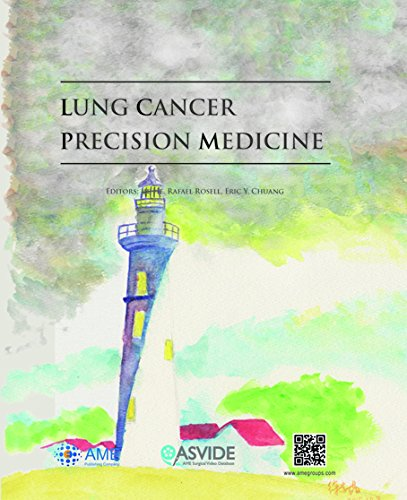
Lung Cancer Precision Medicine
| Editors: | Jie He; Rafael Rosell; Eric Y Chuang |
Publisher: AME Publishing Company; 1st edition (2016)
ISBN-13: 978-9881402813
Hardcover: 610 pages
Language: English
The Lung Cancer Precision Medicine book provides many opportunities for readers to satiate their curiosity for burning issues. Readers will find searched for answers in multiple facets of lung cancer. The distribution of chapters permits a reader to begin the book at any point which is a very novel aspect.
Editors
| Jie He | Department of Thoracic Surgical Oncology, Cancer Institute & Hospital, Chinese Academy of Medical Sciences and Peking Union Medical College; National Cancer Center, Beijing 100021, China |
| Rafael Rosell | Cancer Biology and Precision Medicine Program, Catalan Institute of Oncology, Hospital Germans Trias i Pujol, Ctra Canyet, Badalona (Barcelona), Spain |
| Eric Y. Chuang | Graduate Institute of Biomedical Electronics and Bioinformatics, NTU YongLin Biomedical Engineering, Center National Taiwan University, Taipei, Taiwan |
Table of Contents
Preface
Foreword
Genetic Changes
1 Cancer genome evolution
12 Cancer biomarker discovery and validation
26 Analysis of cancer genomes through microarrays and nextgeneration sequencing
33 Molecular landscape of non-squamous, non-small cell carcinoma of the lung
45 Epidermal growth factor receptor in non-small cell lung cancer
Screening for Lung Cancer
75 Liquid biopsy for cancer screening, patient stratification and monitoring
86 Potential biomarkers for lung cancer screening
Diagnosis of Lung Cancer
96 Development of cancer diagnostics—from biomarkers to clinical tests
106 Molecular testing in lung cancer in the era of precision medicine
116 Molecular methods for somatic mutation testing in lung adenocarcinoma: EGFR and beyond
132 Overview of clinicopathologic features of ALK-rearranged lung adenocarcinoma and current diagnostic testing for ALK rearrangement
139 Circulating DNA in diagnosis and monitoring EGFR gene mutations in advanced non-small cell lung cancer
153 Lung cancer diagnosis and staging in the minimally invasive age with increasing demands for tissue analysis
165 Computer modeling of lung cancer diagnosis-to-treatment process
Treatment of Lung Cancer
176 Techniques to define segmental anatomy during segmentectomy
182 Open, thoracoscopic and robotic segmentectomy for lung cancer
193 Segmentectomy versus lobectomy for clinical stage IA lung adenocarcinoma
200 Lobectomy vs. segmentectomy for NSCLC (T<2 cm)
207 State of the art in surgery for early stage NSCLC—does the number of resected lymph nodes matter?
212 Treatment of stage I lung cancer in high-risk and inoperable patients: SBRT vs. RFA vs. sublobar resection
215 Improving the pathologic evaluation of lung cancer resection specimens
221 Novel radiotherapy approaches for lung cancer: combining radiation therapy with targeted and immunotherapies
229 Exploiting sensitization windows of opportunity in hyper and hypofractionated radiation therapy
247 Improving radiotherapy planning, delivery accuracy, and normal tissue sparing using cutting edge technologies
265 Imaging techniques for tumour delineation and heterogeneity quantification of lung cancer: overview of current possibilities
275 Hyperfractionated and accelerated radiotherapy in non-small cell lung cancer
284 Radiation dose effect in locally advanced non-small cell lung cancer
297 Accelerated dose escalation with proton beam therapy for nonsmall cell lung cancer
306 Combining targeted agents and hypo- and hyper-fractionated radiotherapy in NSCLC
321 New techniques for assessing response after hypofractionated radiotherapy for lung cancer
335 Molecular markers to predict clinical outcome and radiation induced toxicity in lung cancer
349 Lung cancer biomarkers, targeted therapies and clinical assays
361 Angiogenesis inhibition as a therapeutic strategy in non-small cell lung cancer (NSCLC)
370 Management of hyperglycemia from epidermal growth factor receptor (EGFR) tyrosine kinase inhibitors (TKIs) targeting T790Mmediated resistance
378 Hippo/YAP pathway for targeted therapy
387 Targeted therapy in NSCLC driven by HER2 insertions
392 Therapeutic integration of new molecule-targeted therapies with radiotherapy in lung cancer
398 Predicting resistance by selection of signaling pathways
407 The role of the immune system in non-small cell lung carcinoma and potential for therapeutic intervention
421 Immune checkpoint inhibitors in clinical practice: update on management of immune-related toxicities
437 Advances in molecular and immunologic targeted therapies for squamous cell carcinoma of the lung
449 Immune checkpoint blockade for lung cancer: state of the art
Prognosis of Lung Cancer
457 Predicting the prognosis of lung cancer: the evolution of tumor, node and metastasis in the molecular age—challenges and opportunities
466 Prognostic markers in lung cancer: is it ready for prime time?
New Drug Development
476 Integrative oncology drug discovery accompanied by preclinical translational research as prerequisite for clinical development
490 Functional and molecular imaging in cancer drug development
499 New challenge of developing combined radio-drug therapy
Design and Statistical Principles of the Trial
506 Statistical principles for omics-based clinical trials
517 An overview of the NCI precision medicine trials—NCI MATCH and MPACT
525 Design and statistical principles of the SHIVA trial
535 An overview of the design and conduct of the BATTLE trials
548 Lung-MAP—framework, overview, and design principles
554 Designing a definitive trial for adjuvant targeted therapy in genotype defined lung cancer: the ALCHEMIST trials
562 Statistical aspect of translational and correlative studies in clinical trials
568 Biomarker based clinical trial design
576 The spectrum of clinical trials aiming at personalizing medicine
590 Adaptive randomized phase II design for biomarker threshold selection and independent evaluation
600 Drug designs fulfilling the requirements of clinical trials aiming at personalizing medicine


